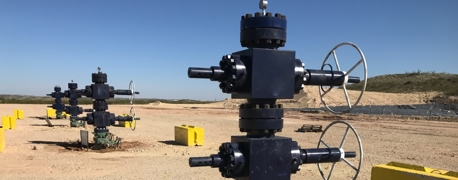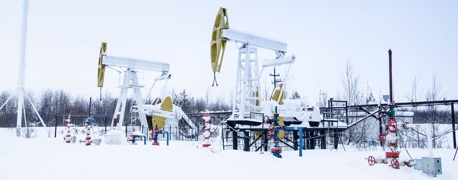Oil Pump Jacks, Worker Safety & Employer Negligence
.2506241603550.jpg)
Oil pump jacks are a common sight for many Americans, whether there’s one drilling in their backyard, along the highway, or on a TV screen. Regardless of their proximity to one, everybody still depends on the oil extraction of these “nodding donkeys” to one degree or another. Of course, those who live within a mile of an oil pump jack also have to deal with serious health and environmental risks. These dangers are even more pronounced for the people who need to keep these oil pump jacks running.
While oil pump jacks are designed to operate continuously and automatically, they still require a great deal of regular maintenance to operate safely. And if employers fail to schedule inspections and repairs, workers on and in the vicinity of oil pump jacks face heightened risks. Even performing said maintenance work comes with its own set of dangers.
These are known dangers, however, so while oil production is a hazard-filled industry, when oilfield workers suffer serious or fatal injuries on the job, it’s usually the result of employer negligence.
Safety Risks of Working on & Around Oil Pump Jacks
Even before arriving at an oil well, workers face repeated safety risks. While some oil pump jacks are set up within busy neighborhoods, many, many others are installed at remote sites. It is the transportation to distant oilfields that accounts for the fact that about 4 out of every 10 oil worker deaths occur in highway crashes, per OSHA.
Some of the dangers that oilfield workers face while on the job include:
- Struck-by/caught-in accidents
- Explosions and fires
- Falls from heights
- High-pressure line blowouts
- Toxic chemical exposure
- Electrical shocks, burns & electrocution
When these locations also occur on someone else’s property, such as when ranchers own surface rights to the land but the oil and gas operator holds mineral rights, oil workers may need to avoid livestock and other animals to keep themselves safe.
Oil Pump Jack Equipment Dangers
Without proper training and supervision, workers may think the oil pump jack moves slowly enough for them to work around it while it’s in motion. Unfortunately, employers who fail to provide proper training may also think that it’s not worthwhile to put guards on the counterweights, or to even provide all workers with hard hats and other necessary personal protective equipment (PPE).
This failure of employers to provide safety protocols and equipment has resulted in workers being:
- Crushed by an oil pump jacks’ counterweight, while picking up debris nearby or performing maintenance work on it
- Killed by an oil pump jack falling on them
- Killed in a fall from an oil pump jack
- Exposed to severe or even lethal electrical shocks while working on or around oil pump jacks
Workers are exposed to many other risks, even equipment dangers, because of corporate negligence. These are just a few examples.
Toxic Exposure Risks Near Oil Pump Jacks
An ever-present threat on an oilfield, hydrogen sulfide can quickly knock people out or even kill them in just a few breaths. Warning signs should be present at the oil pump jack as well as all across the surrounding vicinity, enough to let people know about the potential risks of exposure.
Hydrogen sulfide, or H2S, may also be referred to as:
- Sewer gas
- Swamp gas
- Stink damp
- Sour damp
As the name suggests, hydrogen sulfide gives off a rotten egg smell, but it is not visible. It is poisonous to breathe in and easily catches fire or even explodes.
Once you can smell the gas, it’s approaching hazardous levels of concentration, which can lead to nausea, eyes welling with tears, headaches, and breathing issues. Higher concentrations lead to fatigue, memory problems, and dizziness, while prolonged or acute exposure can cause lung issues, unconsciousness, and death, sometimes quickly or near-instantaneously. In cases of falling unconscious from hydrogen sulfide exposure, even if the area clears of toxic air in time for you to breathe safely again, the fall itself can cause catastrophic injury.
If an employer sends a team to an oil site without hydrogen sulfide monitors, they’re being grossly negligent.
That’s just one toxic chemical. The risk of toxic gas exposure abounds at oilfields, whether directly at the site where the oil pump jack is drilling or by faulty pipelines or storage tanks nearby.
These toxic chemicals include and aren’t limited to:
- Methane
- Carbon monoxide
- Mercury vapor
- Benzene
- Volatile organic compounds (VOCs)
- Nitrous oxide
- And many other toxic-to-breathe and flammable, explosive gases
Oil Pump Jack Fires & Explosions
When it comes to the electrical components of an oil pump jack, as well as the other equipment needed in oil drilling, heightened risks of explosion and fire are present. These all can create sources of ignition if any of the toxic and flammable gases involved in drilling leak out of an oil well, pipelines, or storage tanks.
That is why employers must take safety seriously, providing workers with training and the personal protective equipment they need, while ensuring that protocols are diligently followed, especially inspections and maintenance on all equipment. While OSHA inspectors and regulators may be infamously lacking in their efforts to keep worksites up to code, employers have all the knowledge they need to ensure that these codes are followed anyway. All they need to do is prioritize worker safety. Employers can and should prevent explosions, fires, and contact with or inhalation of hazardous chemicals at oilfields.
Workplace Accidents Involving Oil Pump Jacks
While there are many other examples of workplace accidents in an oilfield, the following incidents illustrate how dangerous an oil pump jack can be. Any lapses in a company’s safety protocols can quickly turn deadly for workers as they work on and around such powerful and heavy machinery.
Here are some of the OSHA reports on recent oil pump jack accidents:
- August 2022: A technician was assessing an oil pump jack at a Lewis Petro Properties oil well in Cotulla, Texas, to find out why oil production was low. OSHA's investigation couldn’t determine what happened next, but the technician was either caught in or caught between the equipment before getting struck by the counterweights, crushing his upper torso and killing him. OSHA cited Lewis Petro Properties for serious violations of lockout/tagout procedures, failing to control hazardous energy, failing to inspect energy control procedures, and failing to have lockout/tagout protocols and training in place. For this preventable death, OSHA’s penalty was reduced from $78,125 to $37,500.
- September 2022: When a worker was removing wrist pins from a pump jack counterweight at a TodPat, LLC oil well in Odessa, TX, the counterweights started moving. As a result, the employee was struck by a moving piece of equipment and caught in rotating equipment and killed. The company was fined all of $11,000 for: one serious violation of failing to have clear lockout/tagout procedures in place, another citation for failing to have adequate falling object protection, having an unguarded pulley, and having an unguarded belt.
- October 2023: At an active pump jack site in Covington, Oklahoma, workers performed repairs and maintenance on the stuffing box and polished rod. Once finished, one 26-year-old worker, who was between the Sampson Post legs, turned to the left of the pump jack. He then walked under the counterweight and crank to stand on the outer part of the base frame. The counterweight rotated behind him, catching his shirt and pulling him to the ground, where he was crushed by the counterweight and would eventually succumb to his injuries. T & L Well Service was fined $10,000 by OSHA for this deadly incident, after being cited for lacking machine guarding.
Each of these oil pump jack accidents was tragically fatal, yet OSHA did little more than give a slap on the wrist to each of the companies involved. These employers had committed violations, and it was their workers who paid the price, the workers whose safety was meant to be the employers’ responsibility.
Oilfield Worker Safety Is Essential—and Possible
While there are many dangers in working with or around oil pump jacks, dangers that can injure or kill people in mere seconds, these are known and can be prepared for.
While some of these apply more to remote sites than others, some basic safety rules that can protect workers around oil pump jacks include:
- Knowing the site name and coordinates—information that needs to be provided to emergency services if something happens
- Turning on H2S monitors and calibrating them before being on site, keeping them 9 inches or closer to the face
- Wearing PPE such as hard hats, safety glasses, fire-resistant clothes, safety footwear, hearing protection, etc.
- Knowing and strictly adhering to lockout/tagout procedures
- Performing regular and prompt inspections, maintenance, and repair work as needed on equipment
- Regular safety meetings to talk through general safety protocols as well as risks specific to a site
This applies not just to regular employees, but also temp workers, contractors, and other employees who can fall through the cracks if an employer is not diligent about ensuring everyone on site is thoroughly informed on and prepared for the risk-filled work ahead.
Oil Pump Jack Workers Deserve Better from Employers
Oil pump jack workers perform vital labor, yet many of them find themselves in harm’s way not because of the nature of their job, but because of carelessness and risky cost-cutting on the part of their employers. Employers are responsible for worker safety; for making sure that dangerous machinery like oil pump jacks stay in good repair and have adequate machine guarding, with pipes and storage tanks that are leak-free. Workers are also owed proper training on life-saving protocols, like lockout/tagout procedures, and they also deserve adequate PPE. It is when employers fail in any of these aspects that tragic accidents occur.
As dangerous as oilfields are, workers have the right to a safe workplace there as well. When accidents happen in oilfields, someone other than the harmed worker is at fault, and that fault often lies with the employer. In the aftermath of countless oilfield accidents, Arnold & Itkin has helped injured workers and bereaved families demand that employers be held accountable, while securing compensation that can help these workers and families move forward. No matter how tough the fight, we know how to go toe-to-toe with corporations to get answers, win record-setting results for our clients, and secure justice.
- Categories


